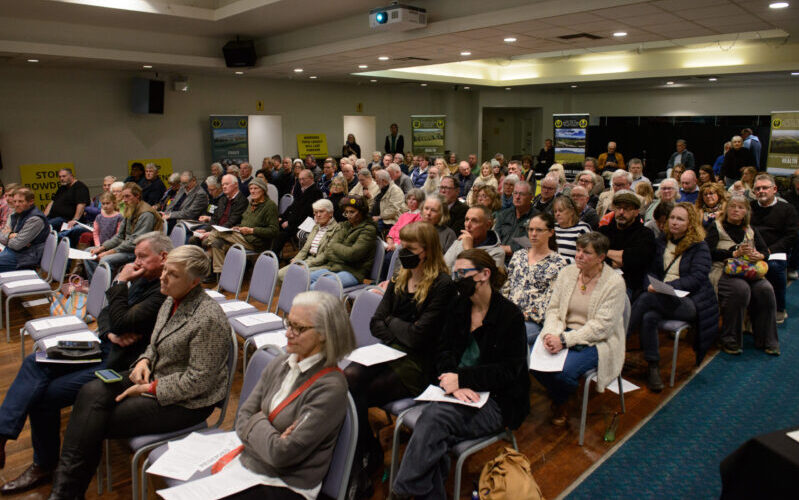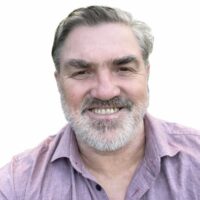The proposed Bowdens Silver Project near Mudgee is meeting with fierce opposition from locals due to the risk of lead poisoning. Michael Sainsbury reports.
There’s a whiff of spring in the hills around the tiny community of Lue just over the mountains from the tourist mecca of Mudgee in mid-west New South Wales. It’s lambing time in a region that prizes its sheep, cattle, olive groves and vineyards that thrive both east and especially west of the town.
Yet just over the hill from the Lue Hotel, plans supported by the mining-friendly government of NSW Labor are threatening the entire region with air and water-borne lead poisoning. Chris Minns’ government has already approved six coal mine extensions and is actively backing the exploration and exploitation of new minerals and metals deposits.
Down the road, Club Mudgee was standing-room-only last Friday.
A cross-section of locals gathered to hear fresh evidence on the proposed lead, zinc and silver mine. They came for a new report commissioned by the Mudgee Region Action Group forecasting an economic hit to tourism and agriculture of up to $2.6 billion between 2025 and 2048.
“The purported economic benefits of this open-cut lead mine are far outweighed by the long-term costs it would impose on the thriving tourism, hospitality, wine, retail, accommodation and agricultural sectors for which the Mudgee region is renowned,” MRAG spokesperson and former Bathurst mayor Gary Rush told MWM,
Why is it called a silver mine when by far the main resources that will be mined are lead and zinc?
Manning Valley mining puts water supply at risk. What’s the scam?
Silver Mines Limited
The company behind the mine sells the upside: more than 300 jobs under a “locals-first” hiring and training plan and a 16-year operation driving “robust economic outcomes,” with updates including removal of cyanide and a day-shift-only roster.
Locals counter that mines import contractors as often as they create new local jobs. Mudgee already groans under the load—four big coal mines to the north have buoyed the economy but left a housing shortfall and stretched services. Neither of the town’s two doctors’ surgeries has been taking new patients since last year.
Opponents want a government-declared exclusion zone to keep the district lead-free—and have invited ministers to see it firsthand.
“We call on the NSW Government to recognise the Mudgee region alongside other prime agricultural, wine producing and tourism areas across NSW, including the Upper, Gloucester and Liverpool Plains, where open-cut mining is prohibited under state planning laws,” Rush said. “All we are asking for is a lead-free Mudgee region.”
Health warnings
The health warnings are not theoretical. Broken Hill, Mount Isa and Port Pirie are bywords for lead contamination.
In Broken Hill, elevated blood-lead levels in children persist despite decades of tighter controls. As recently as 2023, more than half the children tested exceeded recommended limits, according to local health authorities. Mount Isa’s smelter remains a flashpoint, and Macquarie University researchers have documented airborne lead and soil contamination across residential areas. The Queensland Government notes the stakes plainly:
There is no safe level of lead exposure, particularly for children.
Even low levels can have lifelong consequences for learning, behaviour and development,” says Professor Mark Patrick Taylor, Australia’s best-known environmental health scientist. In Port Pirie, despite a $700m smelter upgrade, recent testing still found over 60% of children under five above recommended maximum levels.
Paediatricians and epidemiologists warn that dust and fine particulates travel far from mine sites, often bypassing even the best tailings and dust-control systems.
Moreover, the exploration licences sprawl across grazing, wine and olive country, coming within 2 km of Mudgee, which is now a booming tourism hub.
“It is no exaggeration that any lead mine would be a death warrant for the Mudgee region as one of Australia’s top tourism destinations, wine producing and agricultural areas,” says Bron Wannan, Lue farmer and secretary of the Mudgee Region Action Group.
“In addition to poisoning our waterways, pastures, air and children, the proposed open-cut lead mine will destroy our region’s reputation for clean agricultural produce, quality wine and as one of Australia’s most beloved regional tourism destinations.”
A long time coming
Bowdens was discovered in the 1980s and advanced by owners including CRA (now Rio Tinto) and Kingsgate Consolidated. It was acquired by Silver Mines in 2016.
A 2018 Definitive Feasibility Study envisaged an open-cut mine and 2-million-tonne-per-year plant with an initial capital budget of $246 million. After an Environmental Impact Statement and lengthy consultation, the project won development consent in April 2023, only to have it overturned by the NSW Court of Appeal in August 2024 over an omission in the transmission-line approval.
Silver Mines has since pushed on with “optimisation” studies and a revised planning process to get back on track. The company did not respond to questions from MWM.
Two facts make Bowdens an outlier. First, in October 2021, the Department of Planning rejected opening the Hawkins and Rumker areas to coal exploration, citing community opposition, impacts on Aboriginal heritage and negative effects on Rylstone. Exploration there, it found, “could have negative social impacts on the region, including the town of Rylstone, as a result of large-scale land acquisitions that can accompany the exploration phase of the mining projects.”
The coal area was knocked back despite potential royalties of $917m, versus a projected high-end estimate of $23.6m over Bowdens’ life. Opponents argue Bowdens will have a far greater local impact. The Department did not respond to questions about the discrepancy.
Second, NSW is the only state in Australia where silver is classed a “critical mineral”. The metal was added late in the Coalition era after lobbying by the NSW Minerals Council and Silver Mines, both of which met senior ministers at the time. The label emerged when Bathurst MP Paul Toole, whose electorate covers Rylstone, Kandos and Lu, was Deputy Premier and minister responsible for mines.
Health and environment risks
His National Party rival, Dubbo MP Dugald Saunders, now party leader and Opposition agriculture spokesman, fell back on process. “I have always said that projects like this need to go through all the appropriate checks and balances before approvals are granted,”
The federal member, Andrew Gee, once a National, re-elected this year as an independent, was more direct. “A number of constituents have contacted me about the recent release of the SGS Economics report and have concerns with it.
The New South Wales Ministers for Health, Environment and Planning need to come to the area and address these concerns, which are centred on the impacts of lead on health, agriculture and the wider economy. Community questions should be answered, and the State Member for Dubbo can help by putting pressure on the state Parliament to get these Ministers out here,” Gee said.
Silver Mines touts a 275-million-ounce resource. Extracting it means moving large quantities of lead—an element with a notorious record of poisoning air, soil and water, with children the first casualties. Planned production is 3.4 million ounces of silver per year—and, inevitably, thousands of tonnes of associated lead.
Despite promoting Bowdens as a small, boutique mine, Silver Mines is already pressuring farmers east of the site to grant access for drilling at multiple additional sites. The risk, locals say, is not hypothetical. If contaminated dust or water escapes, and experience across Australia shows it will, Lue, Rylstone, Mudgee and their vineyards and farms will live with the fallout for generations.
Bowdens is a test of how much environmental risk regional Australia is expected to shoulder for resource exports.
Environment minister Murray Watt approves 4.3 billion tonnes of carbon emissions
Michael Sainsbury is a former China correspondent who has lived and worked across North, Southeast and South Asia for 11 years. Now based in regional Australia, he has more than 25 years’ experience writing about business, politics and human rights in Australia and the Indo-Pacific. He has worked for News Corp, Fairfax, Nikkei and a range of independent media outlets and has won multiple awards in Australia and Asia for his reporting. He is a fierce believer in the importance of independent media.

